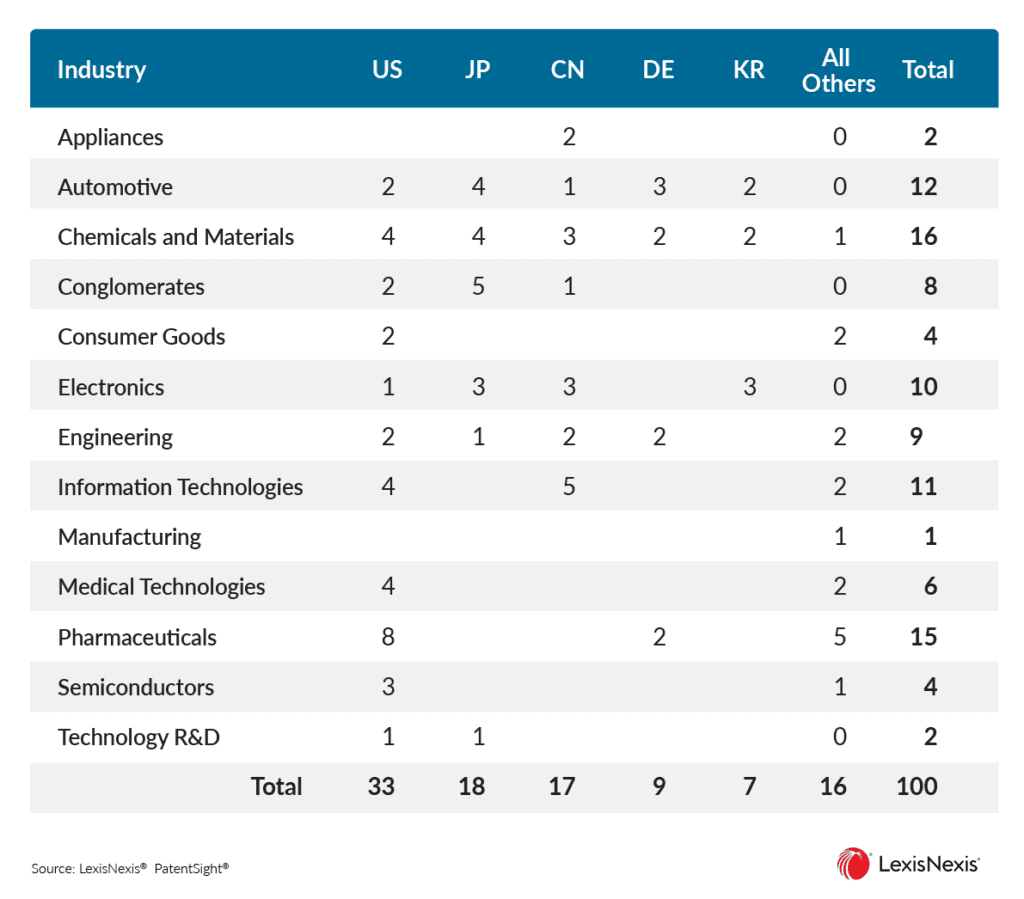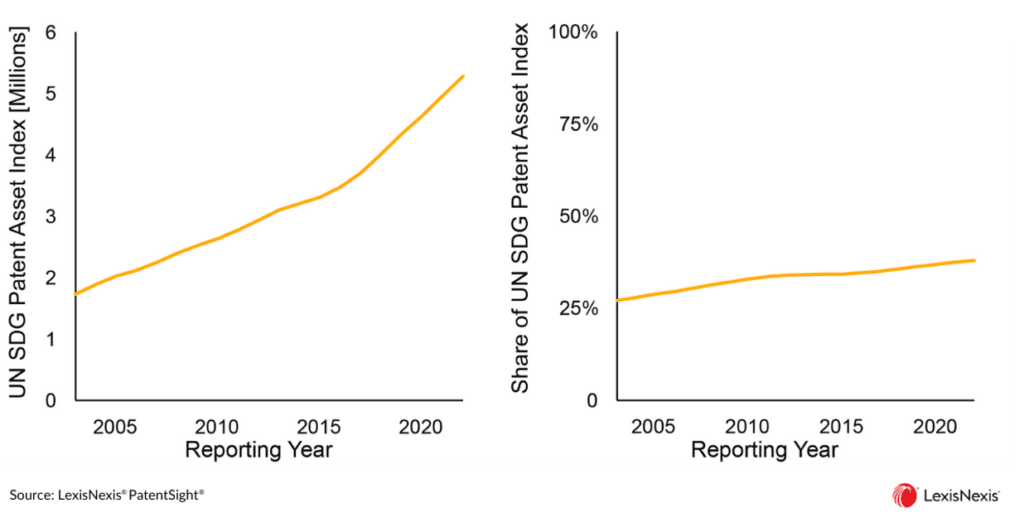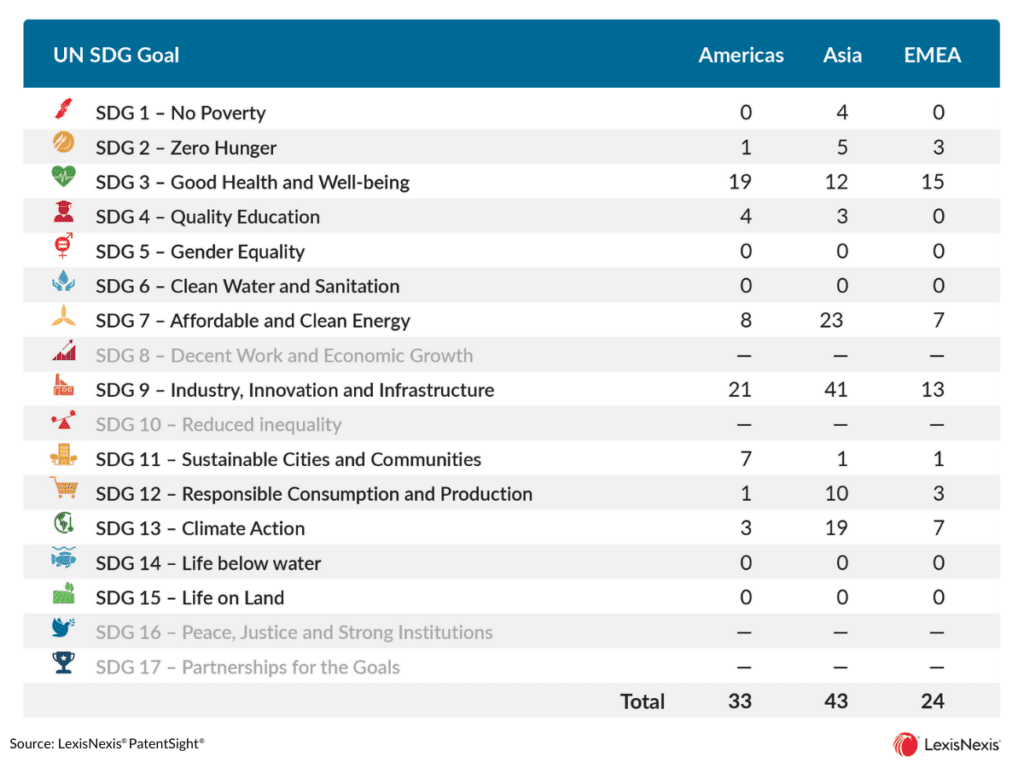The Global Hotspots of Sustainable Innovation: The Regions With the Most Sustainability Leaders

In an era where climate change and sustainable practices are increasingly discussed on global stages, we seek to understand the innovators leading the charge. Our recently published comprehensive study “Exploring the Global Sustainable Innovation Landscape: The Top 100 Companies and Beyond” leveraged patent analytics to uncover fascinating trends in the global commitment to achieving the United Nations’ Sustainable Development Goals (SDGs). This piece dives into the evolving landscape of sustainable innovation, uncovering the leading regions and some of their champions.
Read about the strongest inventions across the United States, Japan, China, Germany, and Korea, spanning technologies from healthcare, technology, automobile, electronics, and utility giants leading sustainable innovation. We’ll also explore how regional governmental policies have influenced this growth and the lessons we can learn for future policy decisions.
In this rapidly transforming landscape of sustainability, patent analytics holds a key role in shaping future strategies.
Spotlight on regions home to sustainability leaders
So, what can we say about the commitment to achieve the SDGs? Our patent analytics report reveals that over the past 20 years, companies worldwide have shown a notable shift to sustainability-focused technologies through their patenting strategies. We see that the number and strength of SDG-related patents have nearly tripled, aligning with the overall growth in patent holdings and filings. Additionally, the share of SDG-related patents in the global portfolio has risen from around 25% to over 30% of the global Patent Asset Index (a qualitative metric used to measure the strength of patent portfolios), as seen in Figure 1. This increase indicates that SDG technologies are growing and surpassing the fast-paced growth of global patent filings.
Growth in quantity (left) and share (right) of SDG-related patent holdings by strength (Patent Asset Index)
Looking at the global landscape of patents, several regions emerged as leaders in sustainable innovation. Based on our qualitative analysis, the ones with the most sustainability-related innovation potential are the United States, Japan, China, Germany, and Korea.
The United States sees significant contributions from healthcare and technology giants such as Johnson & Johnson, Qualcomm, and General Electric, all leading the charge for sustainable innovation in their respective industries.
Japan’s automobile and electronics industries, led by Toyota Motor, Panasonic, and Sony, are making notable contributions towards SDGs.
Meanwhile, China’s telecom titan Huawei, utility conglomerate State Grid, and display manufacturer BOE demonstrate the country’s commitment to sustainable innovation.

A breakdown of the number of patent owners in the Top 100 global leaders in sustainable innovation by region and industry.
In Germany, multinational engineering company Bosch, chemical giant BASF, and automobile leader VW Group have made strides in integrating sustainability into their business models.
Korea’s global technology behemoths Samsung, LG Chem, and LG Electronics continue to prioritize sustainability with high-quality portfolios in their respective technologies.
It’s also important to note the presence of companies spread across Finland, France, Ireland, the Netherlands, Saudi Arabia, Sweden, Taiwan, and Great Britain. Apart from the Top 100 ranking presented in the downloadable report, you can also access an expanded ranking of 300 companies on our website. It’s promising to see such a global dispersion of sustainable innovation, which illustrates our united commitment to sustainable development.
Regional sustainability leaders and government policies
On a broader scale, we observe compelling trends in the Americas, Asia, and the EMEA (Europe, Middle East, and Africa) region. A standout insight is that 95% of Asian companies that made it to our ranking own patents directly linked to a specific SDG – SDG 9: Industry, Innovation, and Infrastructure. This is further evidence of Asia’s commitment to technological growth and sustainability. However, the region does show room for improvement in contributions towards SDG 3: Good Health and Wellbeing, and SDG 11: Sustainable Cities and Communities.
A breakdown of the top 100 patent owners by focus SDG and region. (SDGs 8, 10,16 and 17 are not technology-driven and are therefore not mappable to patents.)
The region-specific distribution of SDG-related patents can also reflect government-initiated science or technology policies. For example, a significant concentration of Japanese companies in the Top 100 list may directly result from the government’s determined focus on the SDGs. In 2016, the prime minister established a task force to promote SDGs nationwide, marking the goals’ inclusion in the official national policy. 1
This governmental drive has spawned initiatives such as the Japan SDGs Award, SDG Future Cities, and the Public-Private Partnership Platform for Local SDGs. These initiatives have successfully raised awareness and inculcated a sense of ownership of the SDGs among Japanese citizens.
Overall, the proactive role taken on by different governments has led to tangible progress on the SDGs and effectively disseminated these principles to the innovation community. Examples like Japan serve as an exemplary case of how policy initiatives can steer a country toward sustainable development and innovation.
Leverage innovation analytics to spot sustainability leaders
Regional development trends in sustainable innovation highlight humanity’s impressive strides in our united pursuit of achieving sustainability. However, the discernible differences across regions underscore the need for context-specific strategies and solutions to address unique challenges. This underlines the vital role that government policies can play in nurturing an environment conducive to sustainable innovation. At the same time, policies can only guide companies in the right direction; measuring their real-world impact has always been vague and unreliable.
With insights from advanced analytics based on patent-to-SDG mapping, decision makers at global technology leaders, governments and investors can more accurately gauge the impact of their efforts and iterate strategies. We can collectively expedite our progress toward a sustainable future by continually monitoring successful practices, learning from them, and adapting strategies accordingly. Such a structured approach will help us address the SDGs more efficiently and build a world where innovation and sustainability intersect.
Let’s collaborate to promote sustainable innovation
We’re eager to connect with you and hear about your IP challenges. Contact our skilled analysts to learn how to track and measure your investments in sustainability.
More information on how we mapped patents to the SDGs can be found here.

Which Companies Own the Strongest Sustainable Technologies?
In a first-of-its-kind report, learn which companies are the world’s leading patent owners with the potential to drive transformative innovation toward the United Nations Sustainable Development Goals (SDGs).


